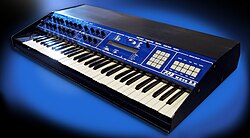Waldorf Music is a German synthesizer company best known for its Microwave wavetable synthesizer and Blofeld virtual analogue synthesizer.
Waldorf Music is a German synthesizer company best known for its Microwave wavetable synthesizer and Blofeld virtual analogue synthesizer.
Waldorf Electronics GmbH was founded in 1988 by Wolfgang Düren, who was then the German distributor for PPG. The name "Waldorf" refers to the German town of Waldorf, located near Bonn, the former capital of West Germany, where the company was established. Later, the company was headquartered at Schloss Ahrenthal.

After the demise of PPG in 1987, Waldorf carried forward the legacy of wavetable synthesis. Using an ASIC designed by Wolfgang Palm, the company developed the Microwave and later the WAVE synthesizers. However, Palm was never employed by Waldorf. The Microwave I, released in 1989, was based on ASICs and a Motorola MC68000 microprocessor. [1] In contrast, the Microwave II, introduced in 1997, was powered by a DSP.
While many other synthesizer manufacturers focused on recreating existing hardware in software, Waldorf took a different approach. In 2002, they introduced the RackAttack, a hardware drum synthesizer, whose synth engine had been released as a VST instrument the year prior.
On 5 February 2004, Waldorf declared insolvency in a German court. Shortly before this, the company had been restructured into an Aktiengesellschaft (Waldorf Music AG), but the effort was unsuccessful.
In the summer of 2006, a new company, Waldorf Music GmbH, was officially established, though it is not a legal successor to the original company. [2] Waldorf's headquarters have since moved to Remagen and are now led by CEO Joachim Flor.
In 2013, Waldorf released NAVE, a synthesizer app for iOS. Their Kyra synthesizer, launched in 2019, became the first fully FPGA-powered synthesizer. [3] In 2014, Waldorf released the Streichfett, a synthesizer designed to recreate the sound of vintage string machines.


 |  |





